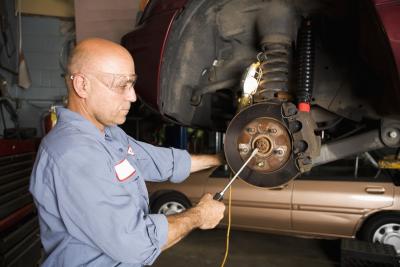
Sliding brakes are properly known as floating brake calipers. The term “caliper” describes the assembly that houses the brake pads and the pistons which actuate them. Floating brake calipers comprise only one piston or pair of pistons; fixed calipers have two or more single pistons or pairs. The floating design is by far the most common type of braking actuator.
The single or twin pistons inside a floating brake caliper push the inboard brake pad onto the disc -- also called the rotor -- when pressure is exerted on the brake pedal, and this action draws the outboard part of the caliper inward onto the opposite side of the disc along a rail, following the basic law of physics that for every action there is an equal and opposite reaction. The inside of the outboard part is also fitted with a brake pad, so the disc is sandwiched between two pads by only one piston or pair of pistons. To do this, the body of the caliper must move parallel to the disc’s rotational axis; it is this movement that gives it the name “sliding brake” in some circles.
Fixed calipers deploy pads from both sides of the disc using separate pistons or pairs of pistons. Although performance is increased, this makes the assembly more costly to produce. More than four pistons per wheel is uncommon in production cars, but up to 12 have been used on high-performance race cars. Although fixed caliper pistons can be vulnerable to contamination, they are typically more long-lasting than floating, or sliding, calipers.
The design of the floating brake allows it to move in tandem with the disc rotating between the pads, maintaining an even amount of pressure as minor deformations of the disc pass through. Because they are a less complex machine, the cost to manufacture, purchase and replace is less than that of their fixed counterparts.
Floating calipers are prone to sticky operation or total seizing, because the rail mechanism must be located where road-borne contamination is at its worst. Dirt and corrosive chemicals can destroy and then enter the protective rubber boot around the mechanism, moisture can pit the mechanism and simple lack of use can cause the apparatus to seize.
If the seize occurs when the brake is deployed, the pads will not back off from the disc when pressure is released from the pedal. At best this will cause premature pad wear and reduced mileage per gallon, and at worst the buildup of friction heat can cause a fire. If the seize occurs when the brake is not deployed, it may be sluggish in subsequent application or not work at all.